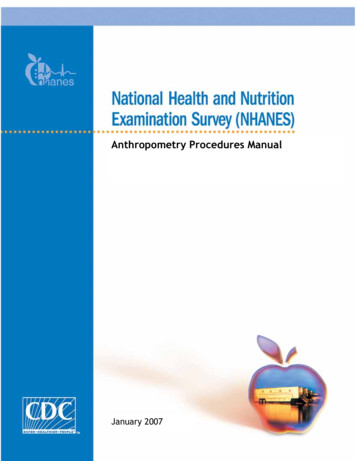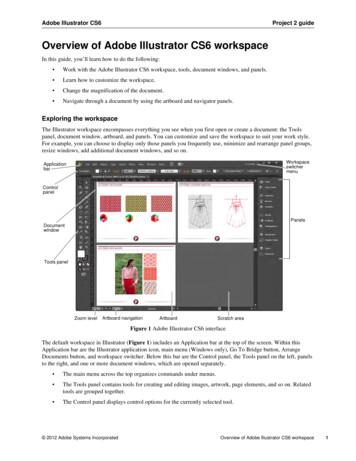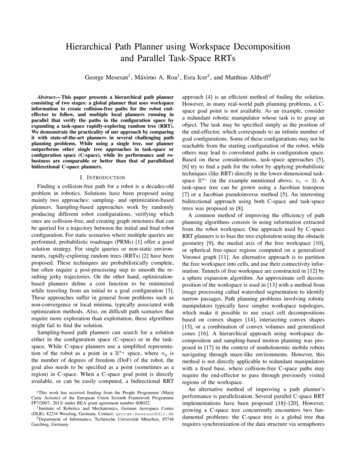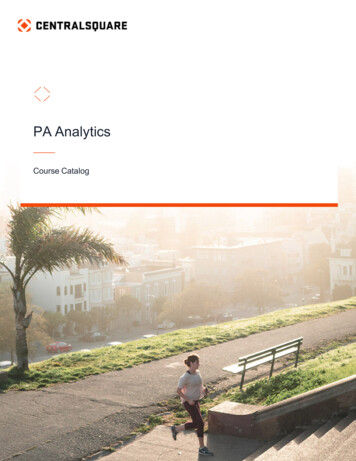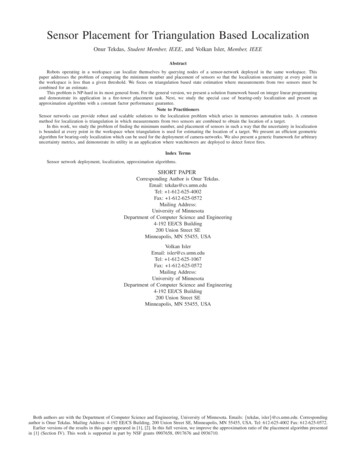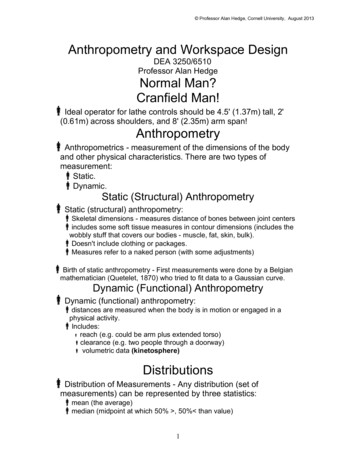
Transcription
Professor Alan Hedge, Cornell University, August 2013Anthropometry and Workspace DesignDEA 3250/6510Professor Alan HedgeNormal Man?Cranfield Man!cIdeal operator for lathe controls should be 4.5' (1.37m) tall, 2'(0.61m) across shoulders, and 8' (2.35m) arm span!AnthropometrycAnthropometrics - measurement of the dimensions of the bodyand other physical characteristics. There are two types ofmeasurement:bStatic.bDynamic.Static (Structural) AnthropometrycStatic (structural) anthropometry:bSkeletal dimensions - measures distance of bones between joint centersbincludes some soft tissue measures in contour dimensions (includes thewobbly stuff that covers our bodies - muscle, fat, skin, bulk).bDoesn't include clothing or packages.bMeasures refer to a naked person (with some adjustments)cBirth of static anthropometry - First measurements were done by a Belgianmathematician (Quetelet, 1870) who tried to fit data to a Gaussian curve.Dynamic (Functional) AnthropometrycDynamic (functional) anthropometry:bdistances are measured when the body is in motion or engaged in aphysical activity.bIncludes:e reach (e.g. could be arm plus extended torso)eclearance (e.g. two people through a doorway)e volumetric data (kinetosphere)DistributionscDistribution of Measurements - Any distribution (set ofmeasurements) can be represented by three statistics:bmean (the average)bmedian (midpoint at which 50% , 50% than value)1
Professor Alan Hedge, Cornell University, August 2013b mode (most frequently occurring number).Normal DistributioncNormal distribution - in a normal distribution all three statistics, the mean,median, and mode are the same. 68% of values in a normal distribution arewithin a standard deviation (SD) of either side of the mean (SD Σ(XMean)2/n-1).c95% are within two SD, and 99% are within 3 SD.bExample: Mean 60", SD 4",e 1 SD 56-64“ - covers 68% of samplee 2 SD's 52-68" - covers 95% of samplee 3 SD's 42-72" -covers 99% of sampleNon-normal DistributionscKurtosis - relates to the shape of the distribution. It's important toplot the data, as it's crucial to know it's shape for analysis. Types ofdistribution shapes include:bBell curve, Gaussian curve (named after Gauss, a physicist), Skewed DistributionscSkew - occurs when one tail of a distribution isdisproportionate to the other tail:bPositive skewbNegative skewStature DistributionsStature DistributionscWithin a gender, the 5th through 95th percentile range covers 90%of people (the top 5% and bottom 5% are excluded).cIn a mixedth total population (50% men, 50% women) the 5ththrough 95 percentile range covers 95% of people (the top 5% ofmen and bottom 5% of women are excluded, but because only halfthe sample are men and half are women this 2.5% 2.5% 5%total sample excluded).Anthropometric Diversity2
Professor Alan Hedge, Cornell University, August 2013cErgonomic designs cannot accommodate every user, the extremes will always be specialcases to be uniquely accommodated.cAnthropometric extremes can be structural dimensions (bones) or contour dimensions (softtissues)Anthropometric DiversitycErgonomic designs must accommodate a range of userdimensions, typically from a 5th percentile woman to a 95thpercentile man.cThis range will accommodate 9.5 out of 10 users.Sitting Height DifferencescNeutral sitting posture for 5th and 95th percentiles (Congleton,1999).cSitting head height for 5th and 95th percentiles.Sitting HeightcSitting height - Stature differences are reduced when sitting down.cSitting height - relative sitting stature sitting height 53% stature, but variesby ethnicity.cDifferent ethnic groups have proportionally different physical characteristics.bMany native African peoples have proportionally longer legs than Europeans.bEastern peoples (Asians) have proportionally shorter lower limbs than WesternEuropeans, in order: Japanese, Chinese, Korean, Thai, and Vietnamese. However, thereis some evidence that this situation is changing e.g. modern Japanese youth haveproportionally longer legs and wider faces than their parents.bIn recent years the Dutch have become the tallest ethnic group (used to be the Dynkapeople of South Sudan).Coefficient of VariationcCoefficient of variation (CV) - useful index of variability of a dimension(CV sd/mean). A low value means that the data are normally distributed( 10). A high value indicates increasing skewness of data.bTypical values are:USeStatureeBody heights (sitting height etc.)eBody breadthseDynamic reacheWeighteJoint rangeseMuscle strength (static)3-4%3-5%5-9%4-11%10-21%7-28%13-85%c68% 1 CV; 95% 2 CVs; 99% 3 CVsCalculating PercentilescZ scores (standard scores)3
Professor Alan Hedge, Cornell University, August 2013Z (Value – Mean)/SDcFor any %ile:Xp mean (SDxZ)e.g. for US adults:mean stature 1755mmSD 71mmZ (for 90th %ile) 1.2890%ile stature 1755 (71 x 1.28) 1755 90.8890%ile stature 1845.88 mm ( 72.6”)Normal Probability GraphscMean and SD can be plotted on normal probability graphpaper to determine any %ile value.cMean 1 SD 84th%ile (84.13)cMean – 1 SD 16th%ile (15.87)Design MythscDesign for the "average" person - since there are no people whose bodydimensions are all at the 50th percentile.bBody dimensions aren't linearly correlated so people with short arms don't necessarilyhave short legs, etc. After about 4 dimensions there’s no highly consistent correlation.bWhile the use of the 5th and 95th percentiles on one body dimension for one homogenouspopulation (e.g. all men) may exclude 10% of the population, the use of these on 13dimensions actually can exclude 52% of the population.Design MythscMyth of designing for 5-95th percentile - designing to include theranges between the 5th and 95th percentiles of anthropometric data fits mostpeople.b5 - 95 percentile for one population is only 90% (95-5% 90% of people), and only 95% fora 50/50 mixed gender population. If you design for 90%, you'll fit 9 out of 10, 90 out of 100,900 out of 1000, etc.bGoodness of fit depends upon relevant anthropometric dimensions (e.g. height won’tnecessarily predict arm length).bAnthropometrics are based on population "norms" - must consider differences if dealingwith specific subpopulations, such as a group of Dutch people or a pro-basketball team.Design MythscAnthropometric data are universal.bUntrue. They are only specific to the populations which they describe. If the population ispoorly specified the percentiles may be biased. Also, percentiles are only specific to thedimension which they describe.cDesign for an adjustable range.4
Professor Alan Hedge, Cornell University, August 2013bThere can be significant cost/benefit tradeoffs as the percentile range is extended. Eachsuccessive percent of the population to be accommodated increases the costs relative tothe benefits, i.e. there are diminishing returns.bMany aspects of adjustability are only necessary is the users cannot be specified.bUsability is most important.Body MorphologycSex differences - shape differences (hip breadth, breast size, abdomendepth) have important ergonomic consequences. Separate data are usuallyused for men and women.cAge differences - body grows then stoops with agecBody shape - soft tissue varies in shape and these variances may createdifferences in clearance and mobility requirements. Sheldon proposed 3somatotypesbmesomorphic - wide thorax, smaller abdomen, strong, muscular bodybectomorph - thin, slender, bony, flat chestedbendomorph - round, soft, large fat storage, pear shaped, full abdomen,smaller thorax, short limbs, fine hair, smooth skin.Sheldon’s SomatotypesSheldon’s SomatotypologySomatotypes and TemperamentDesign AidscData tables - tabular anthropometric data can be difficult to read and use.c Humanscale - a series of templates are used by a computer to change relevant attributes aspopulations change. Values are printed. Unfortunately, it's still necessary to draw the figuresfrom the data values.c Mannequins - a two-dimensional drawing or figure which articulates like ADAM(Anthropometric Data Applications Mannequin) with plastic parts snap together like clearmoveable paper dolls or overlay transparencies.cModels - three-dimensional surface models like "George" can be useful as examples ofanthropometric data. Models have often been used by clothing manufacturers.c Computer generated models - three-dimensional models of a user at a specified percentile incertain respects. Can see elevation, plan, or perspective. An example is "SAMMIE“ (Systemfor Aiding Man-Machine Interaction and Evaluation). Image can be changed to simulatemotion. Can also use strength/force predictions, but we don't have good data for mostbiomechanics.Stature ConsiderationscHeight - Average height of adults steadily declines with age after 20 years of age. Around40 years of age most people start to shrink in stature. Women shrink more than men andshrinkage accelerates with age. This shrinkage occurs in the intervertebral discs of the spine,possibly causing rounding of the back. Some reduction in height may also result fromshrinkage of lower limbs around the joints.cTime of day - Because the cartilaginous discs of the spinal column get compressed bybody weight throughout the day we tend to be slightly shorter in the evening (up to 0.9”).5
Professor Alan Hedge, Cornell University, August 2013Additionally, extremities (like feet) swell throughout the day.Body Weight StrengthcWeight - The average weight of adults increases from ages 20-45. From age 50 onwardmen's weight declines. From age 60 onward women's weight declines. Until 55 years of ageweight increases and there is an increase in hip breadth. Fat is redistributed fromsubcutaneous areas to deeper positions especially around abdominal organs. Lean bodyweight decreases with age as muscles waste away.cStrength - There is a decrease in muscular strength and the mechanical tensile breakingstrength of bone, muscle, and connective tissue decreases with age.PregnancycPregnancy - Later stages of pregnancy decreases in the ability to lift, bend, reach, stand orwalk for long periods, turn head, etc. so it is a form of temporary disability. Assuming a 0.02%pregnancy rate and 50,000,000 women of childbearing age, means an estimated 1,000,000pregnant women at any time. Only recently have anthropometric surveys of pregnant womenbegun to be conducted (in Japan).Wheelchair UsercWheelchair Users - Chairbound people actually suffer three limitations:bCondition which necessitates wheelchair use.bLower eye-level - eye-level is 15 -16" below that of most standing people and the seatedposture also influences reach, controls, and access.bPossession of a cumbersome, awkward, space-consuming, distinctive and inelegantvehicle. While a standing person occupies 25" by 15" of floor space, requires 16" to 26"aisle width and can turn on the spot, a wheelchair user occupies up to 57" by 25" of floorspace, requires minimum aisle clearance of 31.5" and needs a turning circle of between59" and 67".Wheelchair UsersËDesign standards, such as ANSI A1171.1-1980, are available toassist with designs for wheelchair users.Wheelchair UsersDynamic AnthropometricscClearance – the minimum space required for the body or bodysegment to pass through (or not). Maximum breadth and depthdimensions are used (person or technology – e.g. wheelchair).bInclusion – clearance to allow access (e.g. doorway, bathtub, crawlspace,hatch)bExclusion – clearance to prevent access (e.g. safety guard, cage, fancover, air vents)Clearance DimensionsBody Ellipse6
Professor Alan Hedge, Cornell University, August 2013cBody ellipse – in plan view the human body occupies an elliptical shape.So clearance valuesdepend on postural orientation (e.g. in corridors, turnstiles, buses, aisles etc.)Dynamic AnthropometricscReach – dynamic reach envelope (kinetosphere) influenced by:ePosture (sitting standing).eFootbase (increased reach with increased footbase).eWeight in hands (heavy weight decreases reach).eType of grip (pinch power).eProximity to obstacles (wall/obstacle behind person decreases reach).cReach envelopes are highly specific to situations.Zones of Convenient ReachMeasuring Zone of Convenient Reach(ZCR)cMeasure:ba shoulder (acromion) – grip (center of hand) length.b d horizontal distance from shoulder to surface.cr (a2 -d2)cr radius of ZCR.cZCR defines the maximum working area.Zones of Convenient Reach Optimal Visual ZonesNormal Work Area (NWA)cArea described by the arms and hands with the elbows flexed at 90 .cTypically,the comfortable limit of outward rotation is about 25 .Grip Strength and ReachKinetospherecVolumetric reach envelope - used to model optimal workspace layout(e.g. SAMMIE CAD)Workspace LayoutcImportance - most important items should be most central andclosest.cFunction - items with similar functions should be closesttogether.cFrequency-of-use - position most frequently used items in7
Professor Alan Hedge, Cornell University, August 2013optimal locations.cSequence-of-use - position items in optimal locations forsequence of use.cNormal Posture - position items to be accessible from a normalposture.8
b mode (most frequently occurring number). Normal Distribution cNormal distribution - in a normal distribution all three statistics, the mean, median, and mode are the same. 68% of values in a normal distribution are Mean)2/n-1). c95% are within two SD, and 99% are within 3 SD. bExample: Mean 60", SD 4", e 1 SD 56-64" - covers 68% of sample
